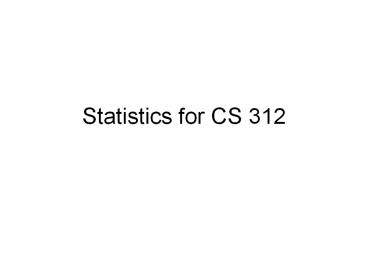Statistics%20for%20CS%20312 PowerPoint PPT Presentation
Title: Statistics%20for%20CS%20312
1
Statistics for CS 312
2
Descriptive vs. inferential statistics
- Descriptive used to describe an existing
population - Inferential used to draw conclusions of related
populations
3
Graphical descriptions
- Histograms
- Frequency polygons/curves
- Pie charts
4
Measures of central tendency
- Mean average used most often
- Median midpoint value used when data is
skewed - Mode most frequently occurring value used
when interested in what most people think
5
Measures of variability
- Range highest value minus lowest value
- Standard deviation average of how distant the
individual values are from the mean
6
Normal curve
- Bell shaped curve 68 of values lie within one
standard deviation of the mean - Non-normal skewed either negatively (tail to
left) or positively (tail to right) - Percentiles - values that fall between two
percentile values - Standard scores distance from mean in terms of
the standard deviation z (X-m) / s. - Z scores transformed standard scores Z 10z
50
7
Variables
- Quantitative things that can be measured (age,
income, number of credits) - Qualitative things without an inherent order
(college major, address)
8
Populations and samples
- Population entire universe from which a sample
is drawn - Sample subset of population
- Symbols mean m, µ standard deviation s, s
variance s2, s2
9
How representative is the sample
- Random sample use random numbers to choose
members of the sample - Stratified sample sample that represents
subgroups proportionally
10
Hypothesis testing
- Hypothesis as to relationship of variables
similar or different - Inference from a sample to the entire population
11
Statistical significance
- Accept true hypotheses and reject false ones
- Based on probability (10 heads in a row occurs
once in 1024 coin tosses) - Significant result means a significant departure
from what might be expected from chance alone - Example a result two standard deviations from
the mean occurs 2.3 of the time in a normally
distributed population
12
Null hypothesis
- Assumption that there is no difference between
two variables - Example Male and female college students do
similar amounts of music downloading using
BitTorrent. - Example School use of computers is unrelated to
income of the students families
13
Levels of significance
- 5 percent level Event could occur by chance
only 5 times in 100 - 1 percent level Event could occur by chance
only 1 time in 100 - Significance level should be chosen before doing
experiment
14
Types of errors
- Type I error Rejection of a true null
hypothesis - Type II error Acceptance of a false null
hypothesis - Decreasing one type increases the other
15
One and two tailed tests
- One tailed test Experimental values will only
fail the null hypothesis in one direction - Two tailed test Values could occur on either
the positive or negative tail of the curve
16
Estimation
- Concerns the magnitude of relationships between
variables - Hypothesis testing asks is there a relationship
- Estimation asks how large is the relationship
- Confidence interval provides an estimate of the
interval that the mean will be in
17
Sequence of activities
- Description
- Tests of hypotheses
- Estimation
- Evaluation
18
Correlation
- Quantifiable relationship between two variables
- Example relationship between age and type of
computer games played - Example relationship between family income and
speed of home computer connection.
19
Correlation chart
- Two (or more) dimensional table
- Variables on the axes, could be intervals
- Scattergram positive correlated values scatter
with positive slope, negative with negative slope
20
Product-moment coefficient
- Formula based on deviations from means
- If deviations are the same or similar, values are
positively correlated - If deviations are the opposite, values are
negatively correlated - Most correlations are somewhere in between 1 and
-1
21
Perfect positive correlation r 1
X Y Y
22
Perfect negative correlation r -1
X Y

